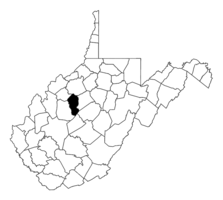 | Back to e-WV
| Back to e-WV
 The West Virginia Encyclopedia
The West Virginia Encyclopedia
 | Back to e-WV
| Back to e-WV
 The West Virginia Encyclopedia
The West Virginia Encyclopedia

Calhoun County, located in west-central West Virginia, has a size of 280.4 square miles with a 2020 population of 6,229, an 18.3 percent decline since 2010. Grantsville is the county seat. Calhoun County is served by U.S. Route 33-119, State Routes 5 and 16, and other roads. Calhoun County is in one of the more remote parts of West Virginia and as a consequence was settled late. The area was favored by hunters and trappers in early times, and nowadays it is one of the places where traditional culture remains strongest.
The Little Kanawha River bisects Calhoun County in the north. The river has played an important role in the region since prehistoric times. Indians followed the river from the Ohio Valley to the rich hunting grounds in central West Virginia. Numerous native artifacts, as well as a few low mounds, have been found in Calhoun County.
Pioneers of European descent also traveled the Little Kanawha and its tributaries. The first recorded permanent settler in the county, Phillip Starcher, arrived in 1810 and built a cabin near present Arnoldsburg. More families trickled in during the early 1800s, including several Revolutionary War veterans. Although the area remained rural, population grew steadily. On March 5, 1856, Calhoun County was created from neighboring Gilmer County.
A fierce competition for the location of the courthouse began immediately. The county seat was moved four times in two years, and the Civil War began before matters could be settled. After the war, the courthouse was relocated one last time, to a farm on the Little Kanawha River. The town that grew up around it was named Grantsville in honor of Gen. Ulysses S. Grant.
The naming of the county seat for the Northern general represented the triumph of a new political faction since the naming of the county for John C. Calhoun, himself a strong proponent of the Southern, states-rights philosophy. Occupying a border county in a border state, Calhoun County residents were divided in their allegiances during the Civil War. They suffered greatly during the wartime chaos. County government ceased to function and citizens lived in confusion and fear. Calhoun’s Moccasin Rangers, a notorious Confederate guerrilla band, controlled much of west-central West Virginia in 1861 and 1862.
The post-war years were marked by slow, steady growth. Timbering became an important economic activity as numerous rafts of logs were floated down the Little Kanawha to Parkersburg. Beginning in the late 1800s, Calhoun County became a major oil and gas producer, with a resulting increase in employment and population. One of the most prominent early entrepreneurs was Godfrey L. Cabot, who built the world’s largest carbon black factory near Grantsville in 1901 and who founded Cabot Gas.
In the absence of railroads and all-weather roads, the river was used to ship merchandise and supplies in and out of the county. At the turn of the century, an important development in river transportation was made by a Calhoun resident, Capt. Norman Williams. His narrow, shallow-draft, gasoline-powered sternwheelers made navigation possible on the upper reaches of the Little Kanawha and its tributaries. Everything from people to mail to oil field equipment traveled on these boats and their barges.
Calhoun Countians have made contributions in various fields. Probably the most prominent native son is the former Congressman, Robert H. Mollohan. Nourished by the rich traditions of their isolated area, Calhoun Countians including Phoeba Parsons and Noah Cottrell contributed to West Virginia’s 20th-century folk music revival.
Calhoun County’s recovery from the Great Depression was slow, and the county suffered from the same out-migration that affected most of the state after World War II. The number of Calhoun Countians peaked at 12,455 in 1940 and declined thereafter, with a population of 6,229 in 2020. The county’s economy in the late 20th century was based on livestock grazing, light manufacturing, and the oil and gas and pipeline construction industries. In 2022, Calhoun County’s largest employers were, respectively, the county school system, Minnie Hamilton Healthcare Center, Momentum Pipeline, Geoforce Utility Technologies, and Waco Foods.
Reforestation has led to a resurgence of timbering and has made the county ideal for hunting and fishing.
Written by Robert G. Bonar
Calhoun County Historical & Genealogical Society. History of Calhoun County. Grantsville: 1990.
Cuthbert, John. Riverboat Days on the Little Kanawha River. Wonderful West Virginia, (January 1996).
Elliott, Mae Stump. Navigation on the Little Kanawha River. Calhoun County Lines and Links, (April 1980).
Mathews, A. G. Transportation in Calhoun County. Grantsville News, August 9, 1956.
Murphy, James M. "Transportation on the Little Kanawha River." M.A. thesis, West Virginia University, 1950.
Holiday, Harry. Early History of the Oil and Gas Industry in Calhoun County.